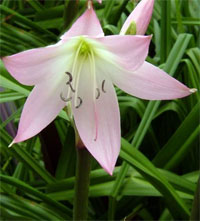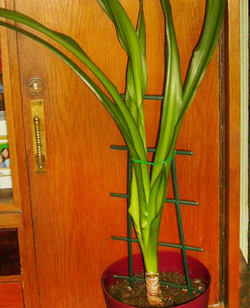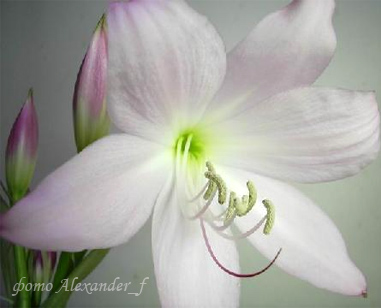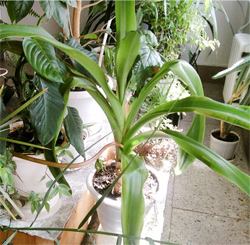
Amaryllis family. Homeland - South Africa. There are about 100 species in nature. Crinum is a chic flowering plant more suitable for growing in greenhouses and winter gardens than in apartments. Not only because plants reach huge sizes, the main reason is the need for cold wintering. They usually bloom in July - September. During the dormant period, most species of crinum do not lose leaves (one to two leaves may turn yellow) and do not tolerate leaf pruning.
- Crinum moorei is a perennial bulbous plant. The bulb is about 15 cm in diameter (can reach 20 cm), spherical in shape, with a high neck, immersed in the substrate half. The leaves are belt-shaped, light green, with a closed vagina forming a false stem. Leaves about 70 cm long. Peduncle up to 50 cm long, umbrella-shaped inflorescence of 6-12 flowers. Perianth bell-shaped, with pointed petals at the end, about 8 cm in diameter, pink or white. Moore's crinum belongs to deciduous or partially deciduous species. I.e. for the rest period it can completely lose leaves.
- Powell's Crinum x powellii is a perennial bulbous plant. The bulb is about 20 cm in diameter, spherical in shape, the neck is shorter than that of Moore's crinum, the bulb is immersed in the substrate half or lower quarter. Leaves are belt-shaped, light green, up to 1 m long, with a closed vagina, forming a rosette. Peduncle up to 1 m long, umbrella-shaped inflorescence of 6-12 flowers. Perianths are bell-shaped, with pointed petals at the end, up to 15 cm in diameter, bright pink, red and white.
- Crinum reddish Crinum erubescens - has an oval bulb about 10 cm wide, the neck is not long. There are many leaves, an average of 60-80 cm long, 5-7 cm wide, belt-shaped, somewhat rough along the edge below. Flowers on very short pedicels or sessile, peduncle 60-80 cm long, 4-6 flowers on each. The flowers themselves are fragrant, the perianth tube is narrow, long, about 10 cm, initially green, gradually reddening. Petals are white, lanceolate, bent back. Flowering in summer.
Crinum care
Temperature: during the growing season, optimally 17-20 ° C, of course, the usual summer temperature is higher, but with extreme heat it is better to rearrange the pot to a cooler place. During the rest period, they are kept at 10-12 ° C practically in dryness, the winter minimum is + 8 ° C, and preferably not higher than 15 ° C. Usually, during the period of rest, it passes independently - with a decrease in daylight hours, watering is gradually reduced. The dormant period occurs in adult plants that have reached the age of 3-4 years and are ready to bloom, crinums under the age of three do not need a cold period, they can be kept in winter at 16-18 ° C.
Lighting: bright diffused light. Shade from direct sunlight, but only in midday hours, morning and evening sun is useful for crinum. In spring, with the beginning of vegetation, they are gradually accustomed to direct sun, first arranging shading from a mosquito net. The ideal location is the east or northwest window. You can contain both southern or western, but here it is dangerous not so much the sun (you can shade), how much heat, so it is imperative to open the window (micro-ventilation or even wider, but without draft).
Watering: plentiful during flowering - the soil should be moist all the time. Avoid waterlogging, krinum, like all amaryllis ones, is sensitive to excess moisture, it is better to check the soil once again by touch, it should have time to dry out in the upper layer. During the rest period, watering is practically stopped, more precisely, watered very rarely, so that the fleshy roots do not dry out at all.
Top dressing: once every two weeks with complex fertilizer for flowering plants, diluted in the concentration recommended by the manufacturer. Feeding begins as soon as young leaves appear and ends with the wilting of the last flowers.
Air humidity: In summer, the leaves are periodically sprayed and wiped with a damp sponge, washing off the dust, checking the pests. In winter, it is necessary by any means to protect the plant from the warm air of the batteries.
 The leaves of the crinum are long, they are easy to injure, it is more correct to tie them to the support.
The leaves of the crinum are long, they are easy to injure, it is more correct to tie them to the support. Crinum moorei hook
Crinum moorei hookTransplantation: Krinums do not like to worry about their roots, so transplantation is carried out as needed - young plants annually, adults about once every 3-4 years, at the end of the dormant period. If fleshy roots accidentally break off, you need to sprinkle them with crushed coal, and after transplantation do not water for a day or two. Soil from 2 parts of clay-turf, 1 part of sheet earth, 1 part of humus, 1 part of peat and 1 part of sand. Add pieces of birch charcoal to the soil. The pot for planting krinum is chosen so that the roots fit into it without creases, freely.
Reproduction: Daughter bulbs in summer. When separating the bulbs, try not to damage the roots. The sections need to be treated with crushed charcoal or ground cinnamon. Young plants bloom only for 3-4 years. When planting daughter onions, it is important to choose the right size of the pot - it should not be too large, otherwise there is a high probability of pouring the plant.


